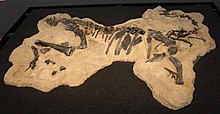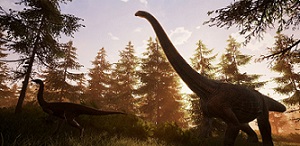
Puertasaurus, one of the largest Dinosaur ever discovered, is a remarkable sauropod dinosaur from the Late Cretaceous period. Its immense size and distinctive characteristics make it a subject of great fascination in the world of paleontology. In this 500-word exploration, we'll delve into its classification, physical characteristics, habitat, behavior, and its significance in our understanding of Earth's prehistoric giants.
Puertasaurus is classified as a titanosaur, a group of long-necked, herbivorous dinosaurs known for their massive size. The first fossils of Puertasaurus were discovered in the Pari Aike Formation of Santa Cruz Province in Patagonia, Argentina. These fossils, dating to the Late Cretaceous period, have provided critical insights into the diversity and size of sauropods during this era.
| Name: | Puertasaurus dinosaurs |
| Size: | Around 98 feet in length. |
| Main Facts: | Puertasaurus, one of the largest dinosaurs, roamed Late Cretaceous South America, highlighting the incredible size diversity within sauropod dinosaurs. |
Puertasaurus is renowned for its colossal size, making it one of the largest known dinosaurs. While specific estimates vary, it is believed to have reached lengths of up to 98 feet (30 meters) or more. Its long neck and tail, combined with a massive body, gave Puertasaurus a distinct sauropod appearance.
Like other sauropods, Puertasaurus had a small head relative to its body, with peg-like teeth suitable for processing plant material. Its massive size was supported by a system of air sacs in its body, which helped reduce the weight of its bones.

Puertasaurus lived during the Late Cretaceous period when much of South America was a lush, verdant environment. Its fossils have been discovered in sediments that suggest it inhabited coastal regions.
As an herbivore, Puertasaurus would have primarily fed on vegetation such as ferns, cycads, and conifers. Its long neck allowed it to reach vegetation high in trees and shrubs, minimizing competition for food among herbivorous dinosaurs.
Regarding behavior, it is likely that Puertasaurus, like other sauropods, moved in herds to reduce the risk of predation. Its massive size would have provided some defense against predators, but it would still have been vulnerable when young.
Puertasaurus is of immense significance in the field of paleontology for several reasons :
Puertasaurus is among the largest known dinosaurs, highlighting the remarkable diversity in size within the sauropod group. Its discovery sheds light on the upper limits of body size that these massive herbivores could attain.
Fossils of Puertasaurus provide valuable data on the Late Cretaceous ecosystems of South America, including the types of plants available and the interactions between herbivores and potential predators.
Puertasaurus represents another branch of sauropod evolution, showcasing the unique adaptations and characteristics of these long-necked dinosaurs in different geographic regions and time periods.
Puertasaurus, a Late Cretaceous titanosaur, was one of the largest dinosaurs to ever roam the Earth, measuring up to 98 feet in length. Its massive body, long neck, and small head characterized its appearance. Like other sauropods, it had peg-like teeth for herbivorous feeding, primarily on ferns, cycads, and conifers.
Puertasaurus inhabited coastal regions in South America, possibly moving in herds to deter predators. Its fossils provide valuable insights into the upper limits of sauropod size and contribute to our understanding of Late Cretaceous ecosystems and the diversity of these awe-inspiring long-necked dinosaurs.
Puertasaurus, one of the largest dinosaurs ever discovered, exhibits both similarities and differences when compared to other dinosaurs, offering valuable insights into the diversity of prehistoric giants.
Puertasaurus belongs to the sauropod group, characterized by their long necks, massive bodies, and herbivorous diets. This places it in the same broader category as other famous sauropods like Brachiosaurus and Diplodocus.
Like many other sauropods, Puertasaurus was an herbivore, feeding primarily on plant material such as ferns, cycads, and conifers.
Puertasaurus stands out for its colossal size, potentially reaching up to 98 feet or more in length. In comparison, while other sauropods were large, they typically did not attain such extreme lengths.
Puertasaurus fossils have been found in South America, particularly in Argentina. In contrast, other sauropods lived in various regions across the globe, including North America, Africa, and Asia.
Puertasaurus existed during the Late Cretaceous period, whereas other sauropods spanned various geological periods. For instance, Brachiosaurus lived during the Jurassic period, and Diplodocus existed in the Late Jurassic.
While Puertasaurus had a long neck typical of sauropods, its neck proportions may have differed slightly from other species due to its unique adaptations.
Due to its massive size, Puertasaurus may have had a distinct ecological role within its Late Cretaceous ecosystem, influencing the types of vegetation it consumed and its interactions with other dinosaurs.